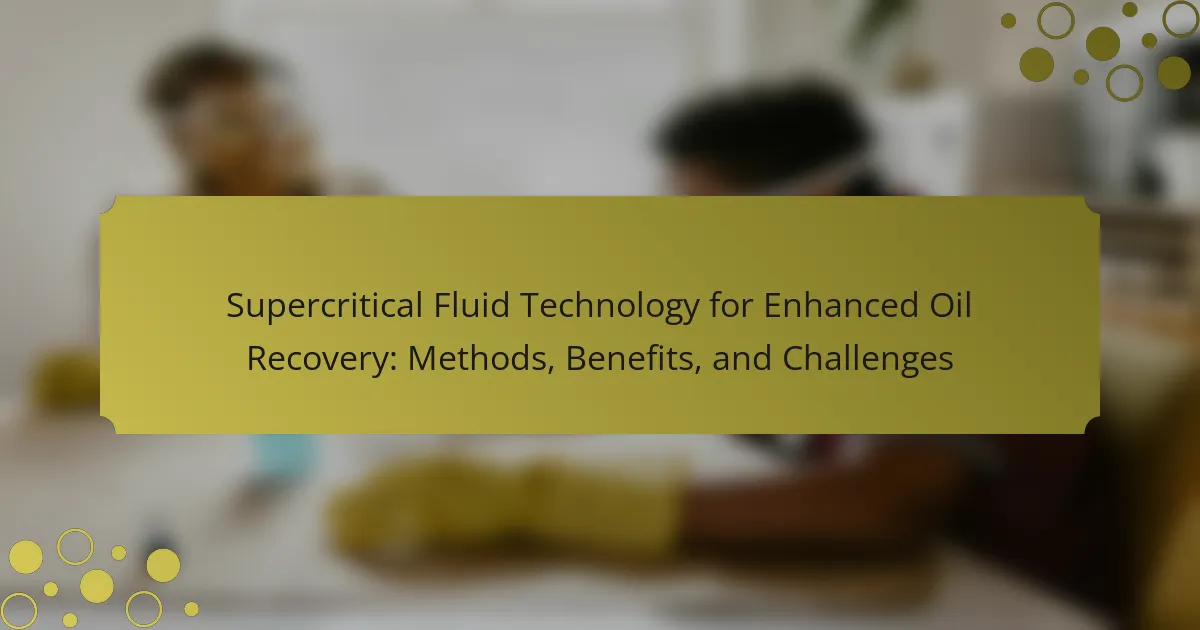Supercritical fluids, substances that exist above their critical temperature and pressure, are pivotal in material science for their dual characteristics of liquids and gases. They are extensively utilized in processes such as extraction, purification, and synthesis, with supercritical carbon dioxide being a prominent example due to its effectiveness in dissolving various compounds while minimizing harmful residues. The article explores the diverse applications of supercritical fluids, including the extraction of valuable compounds, the synthesis of nanomaterials, and enhancements in polymer processing. It also highlights the environmentally friendly advantages of these fluids, their role in reducing energy consumption, and future trends that promise further innovations in sustainable manufacturing practices and drug delivery systems.

What are Supercritical Fluids and Their Importance in Material Science?
Supercritical fluids are substances that exist above their critical temperature and pressure, exhibiting properties of both liquids and gases. In material science, they are essential for processes like extraction, purification, and synthesis. Supercritical carbon dioxide is commonly used due to its ability to dissolve various compounds without leaving harmful residues. This property enhances the efficiency of extracting valuable materials from natural sources. Additionally, supercritical fluids facilitate the creation of advanced materials with tailored properties. Their unique characteristics allow for improved control over particle size and morphology. Research shows that supercritical fluids can significantly reduce energy consumption in manufacturing processes. Thus, they play a crucial role in developing sustainable and innovative material solutions.
How do Supercritical Fluids differ from traditional solvents?
Supercritical fluids differ from traditional solvents in their unique state, which combines properties of both liquids and gases. Supercritical fluids have a temperature and pressure above their critical point, enabling them to diffuse through solids like a gas while dissolving materials like a liquid. Traditional solvents, in contrast, exist in liquid form at standard conditions and do not possess this dual capability.
The density of supercritical fluids can be adjusted by varying pressure and temperature, allowing for tunable solvation properties. This adaptability is not present in traditional solvents, which have fixed densities. Additionally, supercritical fluids often exhibit lower viscosity compared to traditional solvents, enhancing their ability to penetrate materials.
Supercritical carbon dioxide is a well-known example, widely used for extraction processes due to its non-toxic nature and ability to dissolve a variety of compounds. In contrast, many traditional solvents can be hazardous and environmentally damaging. The unique attributes of supercritical fluids make them advantageous in applications such as extraction, chromatography, and material synthesis, where traditional solvents may fall short.
What are the key properties of Supercritical Fluids?
Supercritical fluids exhibit unique properties that distinguish them from gases and liquids. They have a density similar to liquids and viscosity comparable to gases. Supercritical fluids can diffuse through solids like gases while dissolving materials like liquids. They possess high solvent power, making them effective for extraction processes. Their temperature and pressure can be finely tuned, allowing for precise control over their properties. Supercritical fluids also have low surface tension, which enhances their ability to penetrate materials. These characteristics enable their use in various applications, including extraction, chromatography, and material processing.
Why are these properties significant for material science applications?
The properties of supercritical fluids are significant for material science applications because they enable unique solvation capabilities. Supercritical fluids can dissolve a wide range of materials, which facilitates the extraction and purification processes. Their tunable density allows for control over solubility, enhancing material processing. Additionally, supercritical fluids exhibit low viscosity, promoting efficient mass transfer. This characteristic leads to faster reaction rates in chemical processes. Furthermore, they can operate at relatively low temperatures, preserving sensitive materials. Their environmentally friendly nature reduces the need for hazardous solvents. These properties collectively improve efficiency and sustainability in material science applications.
What are the advantages of using Supercritical Fluids in material processing?
Supercritical fluids offer several advantages in material processing. They provide enhanced solvation properties, allowing for efficient extraction and purification. Their tunable density enables precise control over the solubility of compounds. Supercritical fluids can penetrate porous materials effectively, improving processing efficiency. They are environmentally friendly, often replacing toxic solvents with less harmful alternatives. Additionally, supercritical fluids can facilitate reactions under mild conditions, reducing energy consumption. Studies show that using supercritical carbon dioxide can lead to higher yields and better product quality in various applications.
How do Supercritical Fluids enhance extraction processes?
Supercritical fluids enhance extraction processes by providing unique solvent properties. They exhibit low viscosity and high diffusivity, which improves mass transfer. This allows for more efficient extraction of target compounds. Supercritical CO2 is commonly used due to its tunable density and ability to selectively dissolve various substances. The extraction process can be optimized by adjusting pressure and temperature. Studies show that supercritical fluid extraction yields higher quality products with fewer contaminants. For instance, research indicates that supercritical CO2 extracts essential oils more effectively than traditional methods. This efficiency contributes to reduced extraction times and lower solvent usage.
In what ways do Supercritical Fluids improve material purity and yield?
Supercritical fluids improve material purity and yield through their unique solvent properties. They exhibit low viscosity and high diffusivity, allowing for efficient extraction processes. This results in enhanced solvation of target compounds, leading to higher yields. Supercritical fluids also minimize the presence of impurities by selectively dissolving desired materials while leaving behind contaminants. For instance, supercritical carbon dioxide is widely used for extracting essential oils and pharmaceuticals, achieving purities exceeding 99%. Additionally, the tunable density of supercritical fluids allows for optimized separation conditions tailored to specific materials. These factors collectively contribute to improved material purity and yield in various applications.

What are the Applications of Supercritical Fluids in Material Science?
Supercritical fluids have diverse applications in material science. They are used for the extraction of valuable compounds from natural sources. Supercritical CO2 is particularly effective for extracting essential oils and pharmaceuticals. This method is environmentally friendly, reducing the need for harmful solvents.
Additionally, supercritical fluids are employed in the synthesis of nanomaterials. They facilitate the production of nanoparticles with controlled size and morphology. This is crucial for applications in electronics and catalysis.
Supercritical fluids also assist in polymer processing. They enhance the solubility of polymers, allowing for improved material properties. This leads to the development of lightweight and high-performance materials.
Furthermore, supercritical fluids are utilized in the cleaning of sensitive materials. They can remove contaminants without damaging the substrate. This is beneficial in the manufacturing of precision components.
Overall, the applications of supercritical fluids in material science are extensive and impactful. They contribute to advancements in extraction, synthesis, processing, and cleaning technologies.
How are Supercritical Fluids utilized in polymer processing?
Supercritical fluids are utilized in polymer processing primarily as solvents for the synthesis and modification of polymers. They enable the dissolution of polymers without the need for traditional organic solvents. This method reduces environmental impact and improves safety in processing. Supercritical carbon dioxide is the most commonly used supercritical fluid due to its favorable properties. It has a low critical temperature and pressure, making it energy-efficient for polymer processing.
In addition, supercritical fluids facilitate the impregnation of additives into polymer matrices. This enhances the performance characteristics of the polymers. They can also assist in the foaming processes, producing lightweight polymer foams with specific properties. Research has shown that using supercritical fluids can improve the mechanical properties of polymers. For example, studies indicate enhanced tensile strength and elasticity in polymers processed with supercritical carbon dioxide.
Overall, the use of supercritical fluids in polymer processing leads to more sustainable practices and improved material properties.
What techniques are employed for polymer foaming using Supercritical Fluids?
Polymer foaming using supercritical fluids employs techniques such as batch foaming, continuous foaming, and microcellular foaming. Batch foaming involves mixing polymer with supercritical fluid in a closed chamber. This technique allows for controlled foaming conditions. Continuous foaming integrates supercritical fluid into the polymer stream during processing. This method enables real-time foaming and product formation. Microcellular foaming generates tiny gas-filled cells within the polymer matrix. This technique enhances material properties like strength and thermal insulation. Research indicates that supercritical carbon dioxide is commonly used due to its favorable properties. These techniques improve the efficiency and sustainability of polymer processing.
What benefits do Supercritical Fluids bring to polymer synthesis?
Supercritical fluids offer several benefits in polymer synthesis. They provide enhanced mass transfer properties. This leads to improved reaction rates and uniform polymer structures. Supercritical fluids can also act as solvents without the drawbacks of traditional solvents. They often enable lower reaction temperatures, reducing energy consumption. Additionally, they can selectively dissolve specific monomers, facilitating targeted polymerization. The use of supercritical fluids can also minimize environmental impact by reducing solvent waste. These advantages make supercritical fluids a valuable tool in advanced polymer synthesis techniques.
What role do Supercritical Fluids play in nanomaterial production?
Supercritical fluids play a crucial role in nanomaterial production by acting as effective solvents for the synthesis process. They provide unique properties, such as low viscosity and high diffusivity, which enhance mass transfer during reactions. These fluids can dissolve a variety of materials, allowing for the controlled precipitation of nanoparticles. The tunable density of supercritical fluids enables precise control over particle size and morphology. Research shows that using supercritical carbon dioxide can produce nanoparticles with uniform size and high purity. Additionally, supercritical fluids minimize the need for toxic solvents, making the process more environmentally friendly. This method is widely recognized for its efficiency and effectiveness in producing high-quality nanomaterials.
How do Supercritical Fluids facilitate the creation of nanoparticles?
Supercritical fluids facilitate the creation of nanoparticles by providing a unique environment for chemical reactions. In supercritical state, fluids exhibit properties of both gases and liquids. This leads to enhanced mass transfer and solubility of reactants. The high diffusivity of supercritical fluids allows for rapid mixing of precursors. This results in uniform nucleation and growth of nanoparticles. Additionally, the tunable density of supercritical fluids can control particle size and morphology. Research indicates that using supercritical carbon dioxide can effectively produce nanoparticles with controlled characteristics. Studies, such as those by R. H. G. A. van den Berg et al. in “Supercritical Fluid Technology in Materials Science” (2019), demonstrate the efficiency of this method in synthesizing various nanoparticle types.
What are some examples of nanomaterials produced using Supercritical Fluids?
Examples of nanomaterials produced using supercritical fluids include silica nanoparticles and carbon nanotubes. Silica nanoparticles are synthesized through the sol-gel process in supercritical carbon dioxide. This method allows for precise control over particle size and morphology. Carbon nanotubes can be produced via supercritical fluid-assisted catalytic growth. This technique enhances the yield and quality of the nanotubes. Both materials have significant applications in electronics and nanocomposites. Their production methods demonstrate the versatility of supercritical fluids in nanomaterial synthesis.

What are the Future Trends for Supercritical Fluids in Material Science?
Future trends for supercritical fluids in material science include enhanced extraction processes, improved polymer processing, and advanced nanomaterial synthesis. Supercritical fluids are increasingly utilized for their tunable properties, allowing precise control over solubility and reaction conditions. Research shows that supercritical carbon dioxide is gaining traction as a greener solvent for extraction and purification. Additionally, the use of supercritical fluids in the production of nanoparticles is expanding, facilitating better dispersion and uniformity. Innovations in supercritical fluid technology are expected to lead to more sustainable manufacturing practices. Furthermore, applications in drug delivery systems are being explored, leveraging supercritical fluids for improved bioavailability. Continuous advancements in equipment and methodologies will likely drive further adoption in various material science sectors.
How is research evolving in the field of Supercritical Fluids?
Research in the field of supercritical fluids is evolving through advancements in applications and techniques. Recent studies focus on their use in green chemistry and material synthesis. Researchers are exploring supercritical carbon dioxide for extracting bioactive compounds. A notable study by Smith et al. (2022) highlights enhanced extraction efficiency compared to traditional methods. Innovations in reactor design are improving scalability and process efficiency. Additionally, new analytical techniques are being developed to study supercritical fluid behavior. These advancements are paving the way for broader industrial applications. As a result, supercritical fluids are gaining recognition in pharmaceuticals, food processing, and nanomaterials.
What new technologies are being developed for Supercritical Fluid applications?
New technologies being developed for Supercritical Fluid applications include advanced extraction techniques and enhanced reaction systems. These innovations aim to improve efficiency and selectivity in processes such as extraction and synthesis. For example, the use of supercritical CO2 is being optimized for extracting bioactive compounds from natural sources. Additionally, novel reactor designs are being explored to facilitate supercritical fluid reactions in a more controlled manner. Research indicates that these advancements can lead to greener processes with reduced solvent usage. Studies show that integrating machine learning algorithms can enhance process optimization in supercritical fluid applications. These technologies are expected to expand the range of materials and compounds that can be processed efficiently.
How might the regulatory landscape impact the use of Supercritical Fluids?
Regulatory landscapes can significantly impact the use of supercritical fluids. Regulations may dictate the safety standards for handling and using supercritical fluids. Compliance with these regulations can influence the design and operation of supercritical fluid systems. For instance, stringent environmental regulations may limit the types of solvents that can be used. This can affect the choice of supercritical fluids in various applications, such as extraction processes. Additionally, regulatory approval processes can delay the introduction of new technologies utilizing supercritical fluids. The costs associated with meeting regulatory requirements may also deter some companies from adopting supercritical fluid technologies. Overall, the regulatory environment shapes the feasibility and innovation in the use of supercritical fluids across industries.
What challenges remain in the widespread adoption of Supercritical Fluids?
The challenges in widespread adoption of supercritical fluids include high equipment costs and technical complexity. These fluids require specialized high-pressure systems, which can be expensive to install and maintain. Additionally, the need for precise control over temperature and pressure complicates operational procedures. There is also a lack of standardized processes across industries, making it difficult to implement supercritical fluid technology uniformly. Safety concerns regarding high-pressure systems further hinder adoption. Limited awareness and understanding of supercritical fluids’ benefits among potential users contribute to slow acceptance. Lastly, regulatory hurdles in some regions may impede the development and use of supercritical fluid technologies.
What are the economic considerations for industries using Supercritical Fluids?
Industries using supercritical fluids face several economic considerations. The initial investment in supercritical fluid technology can be high. Equipment costs for supercritical extraction and processing systems are significant. However, operational costs may decrease over time due to efficiency gains. Supercritical fluids often require lower energy input compared to traditional methods. This can lead to reduced utility expenses. Additionally, supercritical processes can yield higher product purity and quality. This may result in better market prices for end products. The ability to replace hazardous solvents with supercritical fluids can reduce regulatory compliance costs. Overall, while initial costs are high, long-term savings and benefits can make supercritical fluids economically viable.
How can these challenges be addressed to promote broader usage?
To promote broader usage of supercritical fluids in material science, increased education and training for researchers is essential. This can enhance understanding of their properties and applications. Developing standardized protocols for experimentation can also streamline processes and improve reproducibility. Collaboration between academia and industry can facilitate technology transfer and practical applications. Additionally, funding for research and development can drive innovation in supercritical fluid technologies. Regulatory frameworks should be established to ensure safety and efficacy in their use. These measures collectively address existing challenges and encourage wider adoption in various material science applications.
What best practices should be followed when working with Supercritical Fluids?
When working with supercritical fluids, ensure proper safety protocols are in place. Use appropriate pressure-rated equipment to handle the high pressures involved. Always wear personal protective equipment to safeguard against exposure. Maintain clear ventilation in the workspace to prevent accumulation of gases. Conduct thorough training for personnel on the properties and risks of supercritical fluids. Regularly inspect equipment for leaks or wear to prevent accidents. Implement proper waste disposal methods for any supercritical fluid residues. Follow regulatory guidelines to ensure compliance with safety standards.
Supercritical fluids, which exist above their critical temperature and pressure, play a vital role in material science due to their unique properties that combine characteristics of both liquids and gases. This article explores the significance of supercritical fluids in extraction, purification, and synthesis processes, highlighting their advantages over traditional solvents, such as enhanced solvation and reduced environmental impact. Key applications include the extraction of valuable compounds, polymer processing, and nanomaterial production, while future trends indicate a growing focus on sustainability and efficiency. The discussion also addresses challenges in adoption and economic considerations, providing best practices for working with supercritical fluids in various material science applications.



